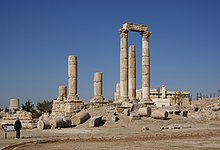Jordan Archaeological Museum
متحف الآثار الأردني | |
| Coordinates | 31°57′14″N 35°56′03″E / 31.9540°N 35.9343°E |
|---|---|
| Type | Art museum, Design/Textile Museum, Historic site |
| Director | Abdul Rahim Al Dwaikat |
The Jordan Archaeological Museum is located in the Citadel of Amman, Jordan. Built in 1951,[1] it presents artifacts from archaeological sites in Jordan, dating from prehistoric times to the 15th century. The collections are arranged in chronological order and include items of everyday life such as flint, glass, metal and pottery objects, as well as more artistic items such as jewelry and statues. Highlights of the museum collections include some of the ʿAin Ghazal statues, which are among oldest statues ever made, and plastered human skulls from Jericho.[2] The museum also includes a coin collection.

History
The museum was established in 1951 on top of Amman's Citadel Hill, among the remains of the Citadel in the heart of the city.
The museum formerly housed some of the Dead Sea Scrolls, including the only Copper scroll, which are now on display in the newly established Jordan Museum, along with some of the Ain Ghazal statues.[3]
Location

The museum is located in the
Time periods represented
The collections of the museum belong to the following periods:
- Paleolithic period: 1,000,000–10,000 years ago
- Neolithic period:
- Pre-Pottery Neolithic (PPN): 8,300–5,500 BC, the most famous artifacts that belong to this period being the Ain Ghazal statues.
- Pottery Neolithic(PN): 5,500–4,300 BC
- Chalcolithic: 4,300–3,300 BC
- Bronze Age
- Early Bronze Age: 3,300–1,900 BC
- Middle Bronze Age: 1,900–1,550 BC
- Late Bronze Age: 1,550–1,200 BC
- Iron Age: 1,200–550 BC
- Persianperiod: c. 550–332 BC
- Hellenisticperiod: c. 332–63 BC
- Nabateanperiod
- Roman period
- Byzantineperiod
- Rashidun period
- Umayyadperiod
- Abbasidperiod
- Ayyubidperiod
See also
- British Museum, holding numerous findings from (Trans-)Jordan
- Cincinnati Art Museum, holding dome of the Khirbet et-Tannur reliefs
- Israel Museum (est. 1965), holding most of the Dead Sea Scrolls
- Istanbul Archaeology Museums, holding major findings from the entire Ottoman Empire
- Jordan Museum(est. 2014), now Jordan's main archeological museum
- Louvre, holding the Mesha Stele
- National Museum of Damascus (est. 1919)
- Mshatta facade
- Rockefeller Archeological Museum (est. 1938), formerly the Palestine Archaeological Museum (until 1967)
References
- ^ Visit Jordan information Archived 2019-06-20 at the Wayback Machine.
- ^ "Jordan Archaeological Museum. Art Destination Jordan, Amman". universes.art. Retrieved 2022-12-04.
- ^ The Jordan Museum.
